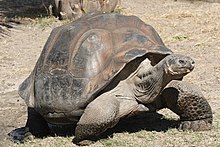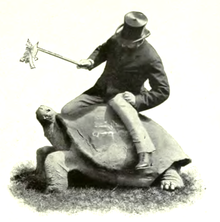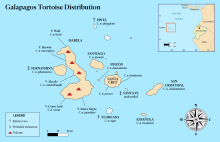
A | B | C | D | E | F | G | H | CH | I | J | K | L | M | N | O | P | Q | R | S | T | U | V | W | X | Y | Z | 0 | 1 | 2 | 3 | 4 | 5 | 6 | 7 | 8 | 9
| Galápagos tortoise | |
|---|---|

| |
| Scientific classification | |
| Domain: | Eukaryota |
| Kingdom: | Animalia |
| Phylum: | Chordata |
| Class: | Reptilia |
| Order: | Testudines |
| Suborder: | Cryptodira |
| Superfamily: | Testudinoidea |
| Family: | Testudinidae |
| Genus: | Chelonoidis |
| Species: | C. niger
|
| Binomial name | |
| Chelonoidis niger | |
| Subspecies[2] | |
| Synonyms | |
|
See section | |
The Galápagos tortoise or Galápagos giant tortoise (Chelonoidis niger) is a very large species of tortoise in the genus Chelonoidis (which also contains three smaller species from mainland South America). The species comprises 15 subspecies (13 extant and 2 extinct). It is the largest living species of tortoise, and can weigh up to 417 kg (919 lb).[3] They are also the largest extant terrestrial cold-blooded animals (ectotherms).[4]
With lifespans in the wild of over 100 years, it is one of the longest-lived vertebrates. Captive Galapagos tortoises can live up to 177 years.[5] For example, a captive individual, Harriet, lived for at least 175 years. Spanish explorers, who discovered the islands in the 16th century, named them after the Spanish galápago, meaning "tortoise".[6]
Galápagos tortoises are native to seven of the Galápagos Islands. Shell size and shape vary between subspecies and populations. On islands with humid highlands, the tortoises are larger, with domed shells and short necks; on islands with dry lowlands, the tortoises are smaller, with "saddleback" shells and long necks. Charles Darwin's observations of these differences on the second voyage of the Beagle in 1835, contributed to the development of his theory of evolution.

Tortoise numbers declined from over 250,000 in the 16th century to a low of around 15,000 in the 1970s. This decline was caused by overexploitation of the subspecies for meat and oil, habitat clearance for agriculture, and introduction of non-native animals to the islands, such as rats, goats, and pigs. The extinction of most giant tortoise lineages is thought to have also been caused by predation by humans or human ancestors, as the tortoises themselves have no natural predators. Tortoise populations on at least three islands have become extinct in historical times due to human activities. Specimens of these extinct taxa exist in several museums and also are being subjected to DNA analysis. 12 subspecies of the original 14–15 survive in the wild; a 13th subspecies (C. n. abingdonii) had only a single known living individual, kept in captivity and nicknamed Lonesome George until his death in June 2012. Two other subspecies, C. n. niger (the type subspecies of Galápagos tortoise) from Floreana Island and an undescribed subspecies from Santa Fe Island are known to have gone extinct in the mid-late 19th century. Conservation efforts, beginning in the 20th century, have resulted in thousands of captive-bred juveniles being released onto their ancestral home islands, and the total number of the subspecies is estimated to have exceeded 19,000 at the start of the 21st century. Despite this rebound, all surviving subspecies are classified as Threatened by the International Union for Conservation of Nature.
The Galápagos tortoises are one of two insular radiations of giant tortoises that still survive to the modern day; the other is Aldabrachelys gigantea of Aldabra and the Seychelles in the Indian Ocean, 700 km (430 mi) east of Tanzania. While giant tortoise radiations were common in prehistoric times, humans have wiped out the majority of them worldwide; the only other radiation of tortoises to survive to historic times, Cylindraspis of the Mascarenes, was driven to extinction by the 19th century, and other giant tortoise radiations such as a Centrochelys radiation on the Canary Islands and another Chelonoidis radiation in the Caribbean were driven to extinction prior to that.
Taxonomy
Early classification
The Galápagos Islands were discovered in 1535, but first appeared on the maps, of Gerardus Mercator and Abraham Ortelius, around 1570.[7] The islands were named "Insulae de los Galopegos" (Islands of the Tortoises) in reference to the giant tortoises found there.[8][9][nb 1]
Initially, the giant tortoises of the Indian Ocean and those from the Galápagos were thought to be the same subspecies. Naturalists thought that sailors had transported the tortoises there.[10] In 1676, the pre-Linnaean authority Claude Perrault referred to both subspecies as Tortue des Indes.[11] In 1783, Johann Gottlob Schneider classified all giant tortoises as Testudo indica ("Indian tortoise").[12] In 1812, August Friedrich Schweigger named them Testudo gigantea ("gigantic tortoise").[13] In 1834, André Marie Constant Duméril and Gabriel Bibron classified the Galápagos tortoises as a separate subspecies, which they named Testudo nigrita ("black tortoise").[14]

Recognition of subpopulations
The first systematic survey of giant tortoises was by the zoologist Albert Günther of the British Museum, in 1875.[15] Günther identified at least five distinct populations from the Galápagos, and three from the Indian Ocean islands. He expanded the list in 1877 to six from the Galápagos, four from the Seychelles, and four from the Mascarenes. Günther hypothesized that all the giant tortoises descended from a single ancestral population which had spread by sunken land bridges.[16] This hypothesis was later disproven by the understanding that the Galápagos, the atolls of Seychelles, and the Mascarene islands are all of recent volcanic origin and have never been linked to a continent by land bridges. Galápagos tortoises are now thought to have descended from a South American ancestor,[17] while the Indian Ocean tortoises derived from ancestral populations on Madagascar.[18][19]
At the end of the 19th century, Georg Baur[20] and Walter Rothschild[21][22][23] recognised five more populations of Galápagos tortoise. In 1905–06, an expedition by the California Academy of Sciences, with Joseph R. Slevin in charge of reptiles, collected specimens which were studied by Academy herpetologist John Van Denburgh. He identified four additional populations,[24] and proposed the existence of 15 subspecies.[25] Van Denburgh's list still guides the taxonomy of the Galápagos tortoise, though now 10 populations are thought to have existed.[26]
Current species and genus names
The current specific designation of niger, formerly feminized to nigra ("black"—Quoy & Gaimard, 1824b[27]) was resurrected in 1984[28] after it was discovered to be the senior synonym (an older taxonomic synonym taking historical precedence) for the then commonly used subspecies name of elephantopus ("elephant-footed" – Harlan, 1827[29]). Quoy and Gaimard's Latin description explains the use of nigra: "Testudo toto corpore nigro" means "tortoise with completely black body". Quoy and Gairmard described nigra from a living specimen, but no evidence indicates they knew of its accurate provenance within the Galápagos – the locality was in fact given as California. Garman proposed the linking of nigra with the extinct Floreana subspecies.[30] Later, Pritchard deemed it convenient to accept this designation, despite its tenuousness, for minimal disruption to the already confused nomenclature of the subspecies. The even more senior subspecies synonym of californiana ("californian" – Quoy & Gaimard, 1824a[31]) is considered a nomen oblitum ("forgotten name").[32]
Previously, the Galápagos tortoise was considered to belong to the genus Geochelone, known as 'typical tortoises' or 'terrestrial turtles'. In the 1990s, subgenus Chelonoidis was elevated to generic status based on phylogenetic evidence which grouped the South American members of Geochelone into an independent clade (branch of the tree of life).[33] This nomenclature has been adopted by several authorities.[2][26][34][35]
Subspecies

Within the archipelago, 14-15 subspecies of Galápagos tortoises have been identified, although only 12 survive to this day. Five are found on separate islands; five of them on the volcanoes of Isabela Island. Several of the surviving subspecies are seriously endangered.[17] A 13th subspecies, C. n. abingdonii from Pinta Island, is extinct since 2012. The last known specimen, named Lonesome George, died in captivity on 24 June 2012; George had been mated with female tortoises of several other subspecies, but none of the eggs from these pairings hatched. The subspecies inhabiting Floreana Island (G. niger)[36] is thought to have been hunted to extinction by 1850,[37][38] only 15 years after Charles Darwin's landmark visit of 1835, when he saw shells, but no live tortoises there.[39] However, recent DNA testing shows that an intermixed, non-native population currently existing on the island of Isabela is of genetic resemblance to the subspecies native to Floreana, suggesting that G. niger has not gone entirely extinct.[36] The existence of the C. n. phantastica subspecies of Fernandina Island was disputed, as it was described from a single specimen that may have been an artificial introduction to the island; however, a live female was found in 2019, likely confirming the subspecies' validity.[40][41][42][43][44]
Prior to widespread knowledge of the differences between the populations (sometimes called races) from different islands and volcanoes, captive collections in zoos were indiscriminately mixed. Fertile offspring resulted from pairings of animals from different races. However, captive crosses between tortoises from different races have lower fertility and higher mortality than those between tortoises of the same race,[45][46] and captives in mixed herds normally direct courtship only toward members of the same race.[46]
The valid scientific names of each of the individual populations are not universally accepted,[47][41][48][49] and some researchers still consider each subspecies to be distinct species.[50][51] Prior to 2021, all subspecies were classified as distinct species from one another, but a 2021 study analyzing the level of divergence within the extinct West Indian Chelonoidis radiation and comparing it to the Galápagos radiation found that the level of divergence within both clades may have been significantly overestimated, and supported once again reclassifying all Galápagos tortoises as subspecies of a single species, C. niger.[52] This was followed by the Turtle Taxonomy Working Group and the Reptile Database later that year.[53][54] The taxonomic status of the various races is not fully resolved.[55]
- Testudo californiana
Quoy & Gaimard, 1824a[31] (nomen oblitum) - Testudo nigra
Quoy & Gaimard, 1824b[27] (nomen novum) - Testudo elephantopus
Harlan, 1827[29] (nomen dubium) - Testudo nigrita
Duméril and Bibron, 1834[14] (nomen dubium) - Testudo planiceps
Gray, 1853[56] (nomen dubium) - Testudo clivosa
Garman, 1917[30] (nomen dubium) - Testudo typica
Garman, 1917[30] (nomen dubium) - Testudo (Chelonoidis) elephantopus
Williams, 1952[57] - Geochelone (Chelonoidis) elephantopus
Pritchard, 1967[58] - Chelonoidis elephantopus
Bour, 1980[59]
C. n. nigra (nominate subspecies)
- Testudo californiana
Quoy & Gaimard, 1824a[31] (nomen oblitum) - Testudo nigra
Quoy & Gaimard, 1824b[27] (nomen novum) - Testudo galapagoensis
Baur 1889[20]
C. n. abingdoni
- Testudo ephippium
Günther, 1875[15] (partim, misidentified type specimen once erroneously attributed to what is now C. n. duncanensis) - Testudo abingdoni
Günther, 1877[60]
C. n. becki
- Testudo becki
Rothschild, 1901[21]
C. n. chathamensis
- Testudo wallacei
Rothschild 1902[23] (partim, nomen dubium) - Testudo chathamensis
Van Denburgh, 1907[24]
C. n. darwini
- Testudo wallacei
Rothschild 1902[23] (partim, nomen dubium) - Testudo darwini
Van Denburgh, 1907[24]
C. n. duncanensis
- Testudo ephippium
Günther, 1875[15] (partim, misidentified type) - Geochelone nigra duncanensis
Garman, 1917[30] in Pritchard, 1996[47](nomen nudum)
C. n. hoodensis
- Testudo hoodensis
Van Denburgh, 1907[24]
C. n. phantastica
- Testudo phantasticus
Van Denburgh, 1907[24]
C. n. porteri
- Testudo nigrita
Duméril and Bibron, 1834[14] (nomen dubium) - Testudo porteri
Rothschild, 1903[22]
C. n. vicina
- Testudo nigra Quoy & Gaimard, 1824
- Testudo californiana Quoy & Gaimard, 1824
- Testudo galapagoensis Baur, 1889
- Testudo elephantopus galapagoensis Mertens & Wermuth, 1955
- Geochelone elephantopus galapagoensis Pritchard, 1967
- Chelonoidis galapagoensis Bour, 1980
- Chelonoidis nigra Bour, 1985
- Chelonoidis elephantopus galapagoensis Obst, 1985
- Geochelone nigra Pritchard, 1986
- Geochelone nigra nigra Stubbs, 1989
- Chelonoidis nigra galapagoensis David, 1994
- Chelonoidis nigra nigra David, 1994
- Geochelone elephantopus nigra Bonin, Devaux & Dupré, 1996
- Testudo california Paull, 1998 (ex errore)
- Testudo californianana Paull, 1999 (ex errore)
- Testudo ephippium Günther, 1875
- Testudo abingdonii Günther, 1877
- Testudo abingdoni Van Denburgh, 1914 (ex errore)
- Testudo elephantopus abingdonii Mertens & Wermuth, 1955
- Testudo elephantopus ephippium Mertens & Wermuth, 1955
- Geochelone abingdonii Pritchard, 1967
- Geochelone elephantopus abingdoni Pritchard, 1967
- Geochelone elephantopus ephippium Pritchard, 1967
- Geochelone ephippium Pritchard, 1967
- Chelonoidis abingdonii Bour, 1980
- Chelonoidis ephippium Bour, 1980
- Geochelone elephantopus abingdonii Groombridge, 1982
- Geochelone abingdoni Fritts, 1983
- Geochelone epphipium Fritts, 1983 (ex errore)
- Chelonoidis nigra ephippium Pritchard, 1984
- Chelonoidis elephantopus abingdoni Obst, 1985
- Chelonoidis elephantopus ephippium Obst, 1985
- Geochelone nigra abingdoni Stubbs, 1989
- Chelonoidis nigra abingdonii David, 1994
- Chelonoidis elephantopus abingdonii Rogner, 1996
- Chelonoidis nigra abingdonii Bonin, Devaux & Dupré, 1996
- Chelonoidis nigra abdingdonii Obst, 1996 (ex errore)
- Geochelone abdingdonii Obst, 1996
- Geochelone nigra abdingdoni Obst, 1996 (ex errore)
- Geochelone nigra ephyppium Caccone, Gibbs, Ketmaier, Suatoni & Powell, 1999 (ex errore)
- Chelonoidis nigra ahingdonii Artner, 2003 (ex errore)
- Chelonoidis abingdoni Joseph-Ouni, 2004
- Testudo becki Rothschild, 1901
- Testudo bedsi Heller, 1903 (ex errore)
- Geochelone becki Pritchard, 1967
- Geochelone elephantopus becki Pritchard, 1967
- Chelonoidis becki Bour, 1980
- Chelonoidis elephantopus becki Obst, 1985
- Chelonoidis nigra beckii David, 1994 (ex errore)
- Chelonoidis elephantopus beckii Rogner, 1996
- Chelonoidis nigra becki Obst, 1996
- Testudo wallacei Rothschild, 1902
- Testudo chathamensis Van Denburgh, 1907
- Testudo elephantopus chathamensis Mertens & Wermuth, 1955
- Testudo elephantopus wallacei Mertens & Wermuth, 1955
- Testudo chatamensis Slevin & Leviton, 1956 (ex errore)
- Geochelone chathamensis Pritchard, 1967
- Geochelone elephantopus chathamensis Pritchard, 1967
- Geochelone elephantopus wallacei Pritchard, 1967
- Geochelone wallacei Pritchard, 1967
- Chelonoidis chathamensis Bour, 1980
- Chelonoidis elephantopus chathamensis Obst, 1985
- Chelonoidis elephantopus wallacei Obst, 1985
- Chelonoidis elephantopus chatamensis Gosławski & Hryniewicz, 1993
- Chelonoidis nigra chathamensis David, 1994
- Chelonoidis nigra wallacei Bonin, Devaux & Dupré, 1996
- Geochelone cathamensis Obst, 1996 (ex errore)
- Geochelone elephantopus chatamensis Paull, 1996
- Testudo chathamensis chathamensis Pritchard, 1998
- Cherlonoidis nigra wallacei Wilms, 1999
- Geochelone nigra chatamensis Caccone, Gibbs, Ketmaier, Suatoni & Powell, 1999
- Geochelone nigra wallacei Chambers, 2004
- Testudo wallacei Rothschild, 1902
- Testudo darwini Van Denburgh, 1907
- Testudo elephantopus darwini Mertens & Wermuth, 1955
- Testudo elephantopus wallacei Mertens & Wermuth, 1955
- Geochelone darwini Pritchard, 1967
- Geochelone elephantopus darwini Pritchard, 1967
- Geochelone elephantopus wallacei Pritchard, 1967
- Geochelone wallacei Pritchard, 1967
- Chelonoidis darwini Bour, 1980
- Chelonoidis elephantopus darwini Obst, 1985
- Chelonoidis elephantopus wallacei Obst, 1985
- Chelonoidis nigra darwinii David, 1994 (ex errore)
- Chelonoidis elephantopus darwinii Rogner, 1996
- Chelonoidis nigra darwini Bonin, Devaux & Dupré, 1996
- Chelonoidis nigra wallacei Bonin, Devaux & Dupré, 1996
- Cherlonoidis nigra wallacei Wilms, 1999
- Geochelone nigra darwinii Ferri, 2002
- Geochelone nigra wallacei Chambers, 2004
- Testudo duncanensis Garman, 1917 (nomen nudum)
- Geochelone nigra duncanensis Stubbs, 1989
- Geochelone nigra duncanensis Garman, 1996
- Chelonoidis nigra duncanensis Artner, 2003
- Chelonoidis duncanensis Joseph-Ouni, 2004
- Testudo hoodensis Van Denburgh, 1907
- Testudo elephantopus hoodensis Mertens & Wermuth, 1955
- Geochelone elephantopus hoodensis Pritchard, 1967
- Geochelone hoodensis Pritchard, 1967
- Chelonoidis hoodensis Bour, 1980
- Chelonoidis elephantopus hoodensis Obst, 1985
- Chelonoidis nigra hoodensis David, 1994
- Testudo phantasticus Van Denburgh, 1907
- Testudo phantastica Siebenrock, 1909
- Testudo elephantopus phantastica Mertens & Wermuth, 1955
- Geochelone elephantopus phantastica Pritchard, 1967
- Geochelone phantastica Pritchard, 1967
- Chelonoidis phantastica Bour, 1980
- Geochelone phantasticus Crumly, 1984
- Chelonoidis elephantopus phantastica Obst, 1985
- Chelonoidis nigra phantastica David, 1994
- Testudo nigrita Duméril & Bibron, 1835
- Testudo porteri Rothschild, 1903
- Testudo elephantopus nigrita Mertens & Wermuth, 1955
- Geochelone elephantopus porteri Pritchard, 1967
- Geochelone nigrita Pritchard, 1967
- Chelonoidis nigrita Bour, 1980
- Geochelone elephantopus nigrita Honegger, 1980
- Geochelone porteri Fritts, 1983
- Chelonoidis elephantopus nigrita Obst, 1985
- Geochelone nigra porteri Stubbs, 1989
- Chelonoidis elephantopus porteri Gosławski & Hryniewicz, 1993
- Chelonoidis nigra nigrita David, 1994
- Geochelone nigra perteri Müller & Schmidt, 1995 (ex errore)
- Chelonoidis nigra porteri Bonin, Devaux & Dupré, 1996
- Testudo elephantopus Harlan, 1827
- Testudo microphyes Günther, 1875
- Testudo vicina Günther, 1875
- Testudo macrophyes Garman, 1917
- Testudo vandenburghi de Sola, 1930
- Testudo elephantopus elephantopus Mertens & Wermuth, 1955
- Geochelone elephantopus Williams, 1960
- Geochelone elephantopus elephantopus Pritchard, 1967
- Geochelone elephantopus guentheri Pritchard, 1967
- Geochelone elephantopus guntheri Pritchard, 1967 (ex errore)
- Geochelone elephantopus microphyes Pritchard, 1967
- Geochelone elephantopus vandenburgi Pritchard, 1967 (ex errore)
- Geochelone guntheri Pritchard, 1967
- Geochelone microphyes Pritchard, 1967
- Geochelone vandenburghi Pritchard, 1967
- Geochelone vicina Pritchard, 1967
- Geochelone elephantopus microphys Arnold, 1979 (ex errore)
- Geochelone elephantopus vandenburghi Pritchard, 1979
- Chelonoides elephantopus Obst, 1980
- Chelonoidis elephantopus Bour, 1980
- Chelonoidis guentheri Bour, 1980
- Chelonoidis microphyes Bour, 1980
- Chelonoidis vandenburghi Bour, 1980
- Geochelone guentheri Fritts, 1983
- Chelonoidis elephantopus elephantopus Obst, 1985
- Chelonoidis elephantopus guentheri Obst, 1985
- Chelonoidis elephantopus microphyes Obst, 1985
- Chelonoidis elephantopus vandenburghi Obst, 1985 Zdroj:https://en.wikipedia.org?pojem=Galapagos_tortoise
Text je dostupný za podmienok Creative Commons Attribution/Share-Alike License 3.0 Unported; prípadne za ďalších podmienok. Podrobnejšie informácie nájdete na stránke Podmienky použitia.
Antropológia
Aplikované vedy
Bibliometria
Dejiny vedy
Encyklopédie
Filozofia vedy
Forenzné vedy
Humanitné vedy
Knižničná veda
Kryogenika
Kryptológia
Kulturológia
Literárna veda
Medzidisciplinárne oblasti
Metódy kvantitatívnej analýzy
Metavedy
Metodika
Text je dostupný za podmienok Creative
Commons Attribution/Share-Alike License 3.0 Unported; prípadne za ďalších
podmienok.
Podrobnejšie informácie nájdete na stránke Podmienky
použitia.
www.astronomia.sk | www.biologia.sk | www.botanika.sk | www.dejiny.sk | www.economy.sk | www.elektrotechnika.sk | www.estetika.sk | www.farmakologia.sk | www.filozofia.sk | Fyzika | www.futurologia.sk | www.genetika.sk | www.chemia.sk | www.lingvistika.sk | www.politologia.sk | www.psychologia.sk | www.sexuologia.sk | www.sociologia.sk | www.veda.sk I www.zoologia.sk
